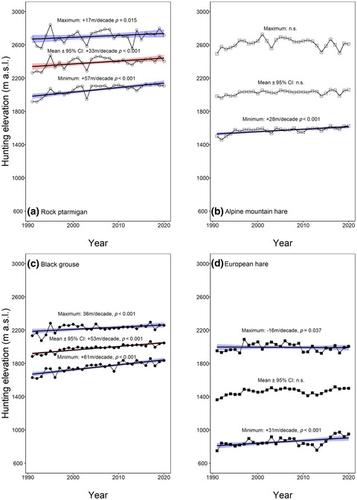当前位置:
X-MOL 学术
›
Glob. Change Biol.
›
论文详情
Our official English website, www.x-mol.net, welcomes your feedback! (Note: you will need to create a separate account there.)
Temperature increase and frost decrease driving upslope elevational range shifts in Alpine grouse and hares
Global Change Biology ( IF 11.6 ) Pub Date : 2021-09-28 , DOI: 10.1111/gcb.15909 Stéphanie C Schai-Braun 1 , Hannes Jenny 2 , Thomas Ruf 3 , Klaus Hackländer 1, 4
Global Change Biology ( IF 11.6 ) Pub Date : 2021-09-28 , DOI: 10.1111/gcb.15909 Stéphanie C Schai-Braun 1 , Hannes Jenny 2 , Thomas Ruf 3 , Klaus Hackländer 1, 4
Affiliation

|
Global climate change has led to range shifts in plants and animals, thus threatening biodiversity. Latitudinal shifts have been shown to be more pronounced than elevational shifts, implying that northern range edge margins may be more capable to keeping pace with warming than upper elevational limits. Additionally, global climate change is expected to disadvantage habitat specialists. In the Alps, climatic variation along the elevation gradient allows the coexistence of habitat specialists and generalists. Alpine species are anticipated to adapt their elevational ranges to the change of various climate variables caused by global climate change. Regional differences might buffer elevational shifts. Furthermore, distinct climate variables might differently affect the shifts of habitat specialists and generalists. To study the effect of climate change on Alpine species, we analysed hunting bag, climate and biogeographical data of two grouse species (Tetrao tetrix and Lagopus muta) and two hare species (Lepus timidus varronis and L. europaeus) in Grisons, Switzerland, over a period of 30 years. Our results based on 84,630 harvested specimens were as follows: (1) only three out of seven climate variables changed significantly within the study period. (2) The grouse species significantly shifted towards higher elevations, whereas the hare species only shifted in their minimum/maximum elevations. (3) Hunting elevation of habitat generalists increased more than in habitat specialists. (4) The elevational shifts were mostly related to the number of frost days. (5) Hunting elevation increased especially in the southern biogeographical region. To conclude, all four taxa respond to climate change but habitat generalists more rapidly than habitat specialists. The range shift to higher elevations due to global climate change will lead to a reduction in habitat availability for snow-adapted species. Climate change is thus a serious threat to alpine biodiversity. Regions rich in alpine habitats will have an increased responsibility to conserve these species.
中文翻译:

温度升高和霜冻减少导致高山松鸡和野兔的上坡海拔范围变化
全球气候变化导致植物和动物的分布范围发生变化,从而威胁到生物多样性。经证明,纬度变化比海拔变化更明显,这意味着北部山脉边缘可能比海拔上限更能跟上变暖的步伐。此外,预计全球气候变化将使栖息地专家处于不利地位。在阿尔卑斯山,沿海拔梯度的气候变化允许栖息地专家和通才共存。预计高山物种将适应其海拔范围以适应全球气候变化引起的各种气候变量的变化。地区差异可能会缓冲海拔变化。此外,不同的气候变量可能会不同地影响栖息地专家和通才的转变。Tetrao tetrix和Lagopus muta ) 和两种野兔 ( Lepus timidus varronis和L. europaeus )) 在瑞士格劳宾登州,历时 30 年。我们基于 84,630 个采集样本得出的结果如下:(1)在研究期间,七个气候变量中只有三个发生了显着变化。(2) 松鸡物种显着地向更高海拔移动,而野兔物种仅在它们的最小/最大海拔移动。(3) 栖息地通才的狩猎海拔比栖息地专家的增加更多。(4) 海拔变化主要与霜日数有关。(5) 狩猎海拔升高,特别是在南部生物地理区。总而言之,所有四个分类群都对气候变化做出反应,但栖息地通才比栖息地专家更快。由于全球气候变化,范围向更高海拔的转移将导致适应雪的物种的栖息地减少。因此,气候变化是对高山生物多样性的严重威胁。高山栖息地丰富的地区将承担更多保护这些物种的责任。
更新日期:2021-11-12
中文翻译:

温度升高和霜冻减少导致高山松鸡和野兔的上坡海拔范围变化
全球气候变化导致植物和动物的分布范围发生变化,从而威胁到生物多样性。经证明,纬度变化比海拔变化更明显,这意味着北部山脉边缘可能比海拔上限更能跟上变暖的步伐。此外,预计全球气候变化将使栖息地专家处于不利地位。在阿尔卑斯山,沿海拔梯度的气候变化允许栖息地专家和通才共存。预计高山物种将适应其海拔范围以适应全球气候变化引起的各种气候变量的变化。地区差异可能会缓冲海拔变化。此外,不同的气候变量可能会不同地影响栖息地专家和通才的转变。Tetrao tetrix和Lagopus muta ) 和两种野兔 ( Lepus timidus varronis和L. europaeus )) 在瑞士格劳宾登州,历时 30 年。我们基于 84,630 个采集样本得出的结果如下:(1)在研究期间,七个气候变量中只有三个发生了显着变化。(2) 松鸡物种显着地向更高海拔移动,而野兔物种仅在它们的最小/最大海拔移动。(3) 栖息地通才的狩猎海拔比栖息地专家的增加更多。(4) 海拔变化主要与霜日数有关。(5) 狩猎海拔升高,特别是在南部生物地理区。总而言之,所有四个分类群都对气候变化做出反应,但栖息地通才比栖息地专家更快。由于全球气候变化,范围向更高海拔的转移将导致适应雪的物种的栖息地减少。因此,气候变化是对高山生物多样性的严重威胁。高山栖息地丰富的地区将承担更多保护这些物种的责任。

























 京公网安备 11010802027423号
京公网安备 11010802027423号